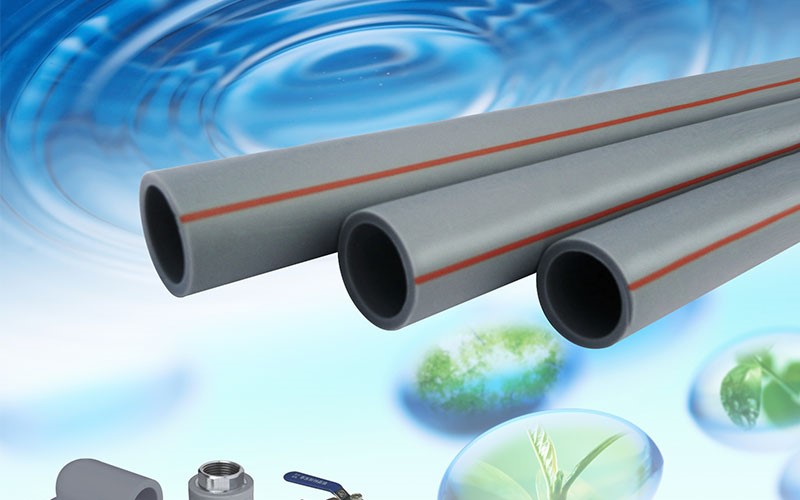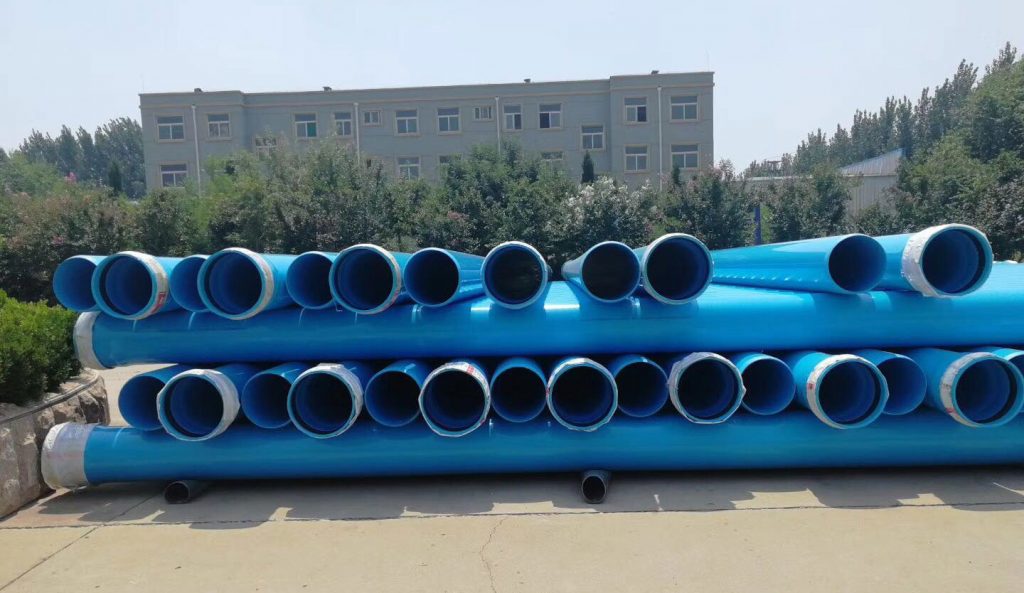The transportation of water for consumption by the general population has seen a few trends and changes over the past several decades. The main contributing factors to the changing demand and trends have been cost and safety.
When we talk about supplying drinking water or water for household use to a large population, safety is the main concern.
The material of the water supply piping needs to be non-reactive so that it can keep the water flowing through it safe from toxins. But since we are speaking of a large network or infrastructure of pipelines, the costs of transport, installation and maintenance also need to balance the safety concern.
What are the types of water supply pipe?
A water distribution network is a large infrastructure of pipes of varying sizes, and in some cases, materials as well. The sizes differ on the basis of diameter and length. The system consists of branches, bends and joints of different types.
The three main components of a water supply network are:
Water mains: This comprises the large pipes that emerge from the city’s drinking water treatment plant. They make up the main artery of the city’s water distribution system. They have a large diameter as they are the main set of pipes to supply the entire area and population. Typically, they are around 3.65 meters in diameter and could be several miles long.
Branch lines: They branch off from the water main pipe and supply a defined area, like a single street or a collection of neighboring buildings. They could be around six inches in diameter. Sometimes they are referred to as the water main.
Goosenecks: A gooseneck is a pipe that branches out from the supply line and carries water to a building. It supplies water to the internal plumbing network of the home or building. It ends at a shutoff valve called the corporation stop, which separates the part of the pipe that belongs to the supplier and the part that belongs to the property owner. These pipes tend to be around 12.7 mm in diameter.


What are the different water supply lines made of?
The three main types of water supply pipes based on material are:
Metal: Metal pipes are built from steel, galvanized iron, cast iron or copper.
Steel is expensive and malleable, and easy to weld to make joints. They are a little bit expensive to transport. And they are durable and can withstand high water pressure.
Galvanized steel or iron are the traditional materials and were used extensively for decades. Static water in the pipes can cause iron pipes to rust, and galvanized steel can impart a metallic taste to the water. Due to these reasons, more non-reactive alternatives have diminished the popularity of these materials.
Cast iron pipes can withstand high water pressure but their weight and unwieldy nature make them costly and difficult to transport and install.
Copper tubing comes in 10 to 20-feet lengths and is fitted with solder, compression fittings using wrenches, or push-on fittings that come in handy in confined spaces.
Cement: The main advantage of concrete cement and asbestos cement pipes are their non-reactive or non-corrosive nature, making them a safe choice for water. But they are heavy, making them difficult to transport, install and join.
Plastic: The three main types of plastics that are used in water pipes are PVC, CPVC, PE, and PPR.
PVC or polyvinyl chloride pipes are light and non-corrosive. They discourage the growth of fungi, bacteria, algae and other biological toxins. In their unplasticized form, however, they are not very malleable, making them unsuitable for plumbing networks that require joints and bends. Plasticized PVC is the most widely used piping material for water supply and is being used to replace older pipes made from metal or cement. Their disadvantages are that they are not suitable for above-ground use because they turn brittle when exposed to ultraviolet light, and cannot withstand temperatures above 140 degrees Fahrenheit. For these reasons, they are used more cold water systems and drainage systems rather than as an outdoor water supply pipe.
CPVC is PVC that is chlorinated to make it more heat-resistant. It can withstand temperatures of up to 200 degrees Fahrenheit, making it suitable for hot water supply as well. They can also withstand higher water pressure when compared to PVC.
PE or polyethylene pipes come in three different densities. High-density PE is untreated PE and I mainly used in drainage systems that are exposed to high temperatures, making it a better choice than PVC. Medium-density PE is more flexible and used for laying longer pipelines for drinking water. Low-density PE cannot withstand high operating pressure and is mostly used in irrigation systems.
PPR pipe means Pipe made of Polypropylene Random Copolymer. PPR pipes are designed as the most hygienic system for the transportation of portable water. PPR and PVC pipe’s main difference is the wall thickness (with the same diameter), PPR pipe is thick and PVC pipe is thin.
What are the common applications of different water lines?
Water distribution systems are designed to serve several purposes:
- 1. Water supply of drinking water
- 2. Drainage pipes that could be internal like tubs and sinks or external like storm water drains.
- 3. Hot water distribution as part of HVAC systems.
- 4. Irrigation systems like sprinklers and water supply for farms and gardens.


Several options for water supply pipes:
PVC is mostly used in drainage systems like sinks, bathtubs, pools and other drains. They are suitable for high-pressure uses and also for cold water distribution They have a high pressure rating but cannot withstand high temperatures. They are inexpensive and readily available. They are easy to install and suitable for jointing. They are not corrosive and are easy to repair. Schedule 40 and 80 are the common types, with 80 having a thicker wall and higher pressure rating. Most building codes do not permit the use of PVC for drinking water distribution.
CPVC is chlorinated PVC and is safe for drinking water supply. They are easy to cut and join and a variety of fittings are available for the purpose. They can withstand higher temperatures than PVC and can be used to supply hot water. This makes them suitable for furnace outlets. The manufacturing and jointing processes are not ecologically friendly.
Polyethylene (PE) is a thermoplastic material produced from the polymerization of ethylene. It is the right choice for projects involving drinking water, exposure to extreme temperatures, or where ungraded or above-ground installation is required.
Among plastic pipes, the PPR pipe is the most popular in plumbing across the world. PP-R raw material is polyolefin, which is non-toxic, sanitary, and reliable. The product can be used not only for the hot and cold water system, but also for the purified drinking water system. PPR cold water pipes are generally used as water pipes, PPR hot water pipes are generally used for heating pipe, also can be used for water heater.
How to choose water supply piping?
A local plumbing professional can advise you about the best choice for you, depending on which part of the plumbing needs to be replaced.
The main considerations to take into account while choosing a pipe are:
- Building and municipal codes and regulations
- Safety
- Cost of installation
- Ease of installation
- Cost of maintenance
What are the advantages of Lesso PVC Pipe for water supply?
- Lesso PVC -U pipes can be used for household, commercial and industrial water supply. Their main advantages are :
- They are non-reactive, non-microbial and non-corrosive, keeping your drinking water safe.
- They are durable and long-lasting. With timely maintenance, they can last up to 50 years or longer.
- The smooth interior walls are designed for low friction and high volume, resulting in faster flow capacity.
- They are fast, easy and inexpensive to install.
- They can be recycled and repurposed after repairs, making them an environmentally-friendly choice.
PE vs PEX pipes for water supply
PE is a safe material and widely approved by local codes for drinking water supply. PEX, however, has aroused grave safety concerns. During the manufacture of PEX, a product called methyl tertiary butyl ether is produced and is a toxin that is also found in gasoline.
PE has been used for over 40 years and has earned trust as a safe medium to transport drinking water. PEX has only been used for 10 years and its long-term effects are not yet known.
PE is durable and lasts for decades with proper maintenance and timely repairs. While PEX does seem durable, it is not yet proven how long it can last under exposure to chemicals, heat, wear and tear.
Compared with PEX pipes, we highly recommend you to choose PPR pipes for home water supply. This type of pipe could be used for both cold and hot water with no toxic. PPR pipes are designed as the most hygienic system for the transportation of portable water.
Lesso provides PVC\PE\PPR pipes, these pipes are for different fields, it is difficult to say which is good and which is not good, it is recommended to choose the appropriate one according to your specific needs.








